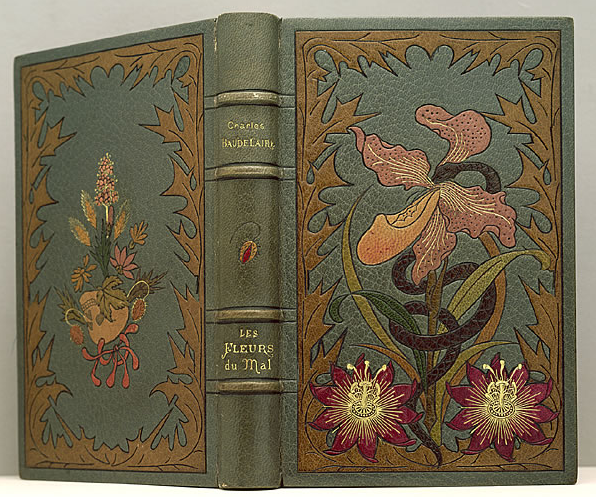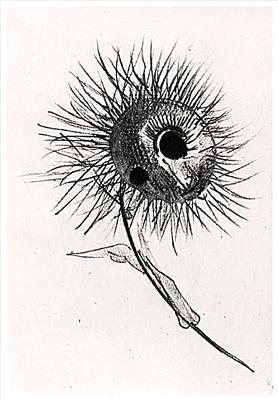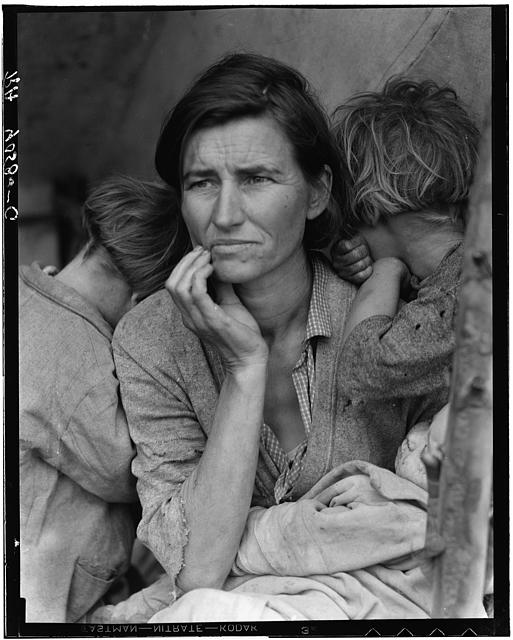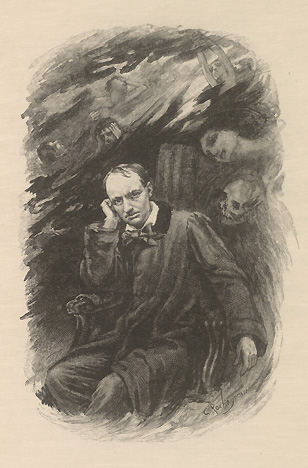
Image Credit: The Harry Ransom Center
Two images related to one of the most respected French poets of the nineteenth century, Charles Baudelaire, grace the Harry Ransom Center’s etched glass façade. Yes, the images of a disturbingly beautiful flower bud and a similarly ominous bouquet on the cover for Baudelaire’s 1857’s collection of poetry, Les Fleurs du mal, are on the Ransom Center’s south and north windows because the Center has holdings of Baudelaire’s work in their French Literature collection. But, maybe the Ransom Center’s choice to use Baudelaire twice when there are many other French authors they could have chosen to represent leads us to another reason why Baudelaire is so prominently represented in the Center’s public face. Baudelaire has always been a dialectical figure of contradiction—twentieth-century literary critic and philosopher Walter Benjamin found in Baudelaire the linchpin around which he could situate the conundrum of urbanity in the nineteenth century. In Benjamin’s unfinished magnum opus The Arcades Project (compiled between 1927-1940), Benjamin muses that the “uninterrupted resonance which Les Fleurs du mal has found up through the present day is linked to a certain aspect of the urban scene, one that came to light only with the city’s entry into poetry. It is the aspect least of all expected. What makes itself felt through the evocation of Paris in Baudelaire’s verse is the infirmity and decrepitude of a great city.” The contradictions of the metropolis—the high and the low, the beautiful and the grotesque—are everywhere in Les Fleurs du mal. Like Benjamin, the Ransom Center uses Baudelaire in their window façade as one figure through which we can view the many contradictions of visual representation and archival work.

Image Credit: The Harry Ransom Center
Baudelaire’s Les Fleurs du mal deals in visual contradictions. The title of Baudelaire’s poetry collection, often translated as “The Flowers of Evil,” immediately makes its main contradiction clear. Flowers are often associated with love, youth, spring, and vitality. Stereotypically, evil is tied to images that are often the opposite of themes associated with flowers. So, a beautiful flower that is simultaneously evil makes for a slight contradiction under typical visual tropes. Baudelaire’s evil flower (illustrated by Odilon Redon) has thistles that look like needles, a single razor-sharp leaf, and large black splotches. Yet, it’s still beautiful.

Image Credit: Library of Congress
The ominous flower in the Ransom Center’s façade brings a visual contradiction to the fore with its placement next to Dorothea Lange’s famous photograph from 1936, Migrant Mother, of a beautifully anxious woman in the Depression. Both images are beautiful, but there is something sinister lurking underneath, whether it’s the evil of the flowers or the worry of the migrant mother. And there are many images like Lange’s or Redon’s that are beautiful but depict something frightening, disgusting, or depressing.

Image Credit: Brown University Library Exhibits
Besides showing that visual images can play with contradictions, Baudelaire can also bring up another contradiction—that of the past in the present. In the portrait above by Georges Rochegrosse, Baudelaire is haunted by the past in the present. To Walter Benjamin, Baudelaire represents this contradiction in his very being. Benjamin is surprised by how the “‘Old-fashioned’ and ‘immemorial’ are still united in Baudelaire. The <things> that have gone out of fashion have become inexhaustible containers of memories.” The past is alive in Baudelaire’s life, and Benjamin explains that “It is very important that the modern, with Baudelaire, appear not only as the signature of an epoch but as an energy by which this epoch immediately transforms and appropriates antiquity.” It is here that Baudelaire represents a quality highly valued by Benjamin—the quality to view the world, with its objects and its people, through a different lens. Like the figure of the collector in The Arcades Project who sees treasures in the relics of the past, Baudelaire sees value in rethinking and reviewing the past in the present. Of course, as a place that houses many archives, the Ransom Center might be equally invested in bringing the past into the present. In using Baudelaire on their façade, the Center could be asking us to think about the contradictions of visual representation and archival work. I think that Walter Benjamin would have been proud.
Recent comments
2 years 29 weeks ago
2 years 44 weeks ago
2 years 44 weeks ago
2 years 50 weeks ago
3 years 4 weeks ago
3 years 4 weeks ago
3 years 4 weeks ago
3 years 6 weeks ago
3 years 6 weeks ago
3 years 6 weeks ago